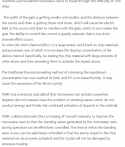It's extremely difficult to find information for precise advances in Chinese EUV systems, I think the Chinese are doing a good job keeping it under wraps. Does anyone know approximately what ASML level eqivalent was the CIOMP EUV prototype? Was it similar to SEMATECH Berkeley Microfield Exposure Tool (2003) or ASML EUV Alpha Demo Tool (2006)? If China reached Alpha Demo Tool in 2017, it would be great news since it means the Chinese EUV programme was only ~10 years behind global leading edge. ASML managed to ship the first pre-production NXE:3100 EUV only 4 years afterwards in 2010, although it was nowhere ready to mass produce chips cost-effectively. Why did it take so long to iterate from NXE:3100 to NXE:3400B before the first commercial EUV chips began mass production? It was almost 10 years.There's been an EUV prototype for well over 10 years at CIOMP. This is more of an R&D project than what you would normally call a prototype associated with some sort of pre-commercial product. They've been experimenting with the components for years but there's been a lack of news on this front. The last update I heard about this was from 2017, linked below.
There has been news involving SSMB as an EUV light source as well as EUV component testing at the SSRF. As far as I know, an SSMB EUV prototype is still in the distant future. Phase II SSMB testing is wrapping up this year with its focus on achieving highly repeatable, high power tunable EUV wavelengths. Phase III is what is supposed to be the basis for an SSMB EUV prototype for a fully integrated lithograph machine. My personal speculation is that the ongoing research at the SSRF will eventually be merged with both the SSMB and LPP EUV light source programs for dual track parallel R&D. What I know for sure is that LPP research is far ahead of SSMB R&D and is already on track for some sort of low output commercialization. This was not certain until not so long ago when rumors came out that China had a working MOPA CO2 laser in the ~30kW range. If true, then it's likely that an LPP EUV machine will be here in the next few years.
Also, what happened to @hvpc? Haven't seen him on this forum for a while and he seem to post pretty insightful stuff.


